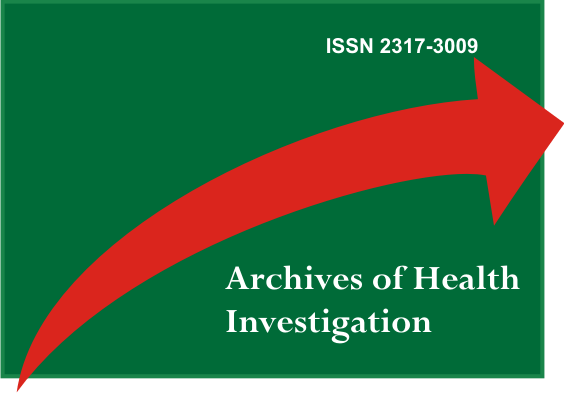Avaliação da morbidade da área doadora do retalho de Grande Dorsal
DOI:
https://doi.org/10.21270/archi.v9i2.4950Resumo
Introdução: As falhas de cobertura nas extremidades são um grande desafio terapêutico. Dentre as várias opções disponíveis para manejo da cobertura encontra-se o retalho livre do Músculo Grande Dorsal, devido sua grande versatilidade e características anatômicas do pedículo. Objetivo: avaliação da morbidade da área doadora do retalho livre de grande dorsal. Métodos: 7 pacientes avaliados em relação a morbidade da área doadora, seja pelo componente estético, álgico e funcional (amplitude de movimento residual). Resultados: 71,4% dos pacientes repetiriam o mesmo procedimento cirúrgico se necessário. 85,7% indicariam o mesmo procedimento para outros pacientes. Discussão: Devido baixa morbidade da área doadora, o retalho livre de grande dorsal encontra-se uma excelente opção na literatura. Nossos dados corroboram com os resultados apresentados em outros estudos, porém com algumas variações na amplitude de movimento mensurada nos pacientes. Conclusões: Devido grande versatilidade e baixa morbidade na área doadora, o retalho livre de Grande Dorsal é uma excelente opção para falhas de cobertura.Descritores: Retalhos Cirúrgicos; Microcirurgia; Procedimentos Cirúrgicos Reconstrutivos.
Referências
- Pederson WC. Nonmicrosurgical coverage of the upper extremity. In: Green´s Operative Hand Surgery. Wolfe SW, Hotchkiss RN, Pederson WC et al. (Org.). 7. Ed. Philadelphia: Elsevier, 2017. cap. 44, p. 1528-1573. v. 2.
- Jobe MT. Microcirurgia. In: Cirurgia Ortopédica de Campbell. Canale ST (Org.). 10. ed. [S.l.]: São Paulo: Manole, 2006. cap. 60, p. 3287-3371. v. 4.
- Spear SL, Hess CL. A review of the biomechanical and functional changes in the shoulder following transfer of the latissimus dorsi muscles. Plast Reconstr Surg. 2005;115(7):2070-73.
- Paolini G, Amoroso M, Pugliese P, Longo B, Santanelli F. Functional sequelae following bilateral mastectomy and immediate reconstruction with latissimus dorsi flap: medium-term follow-up. J Plast Surg Hand Surg. 2014;48(2):99-103.
- Benditte-Klepetko HC, Lutgendorff F, Kästenbauer T, Deutinger M, van der Horst CM. Analysis of patient satisfaction and donor-site morbidity after different types of breast reconstruction. Scand J Surg. 2014;103(4):249-55.
- Nagarkar P, Lakhiani C, Cheng A, Lee M, Teotia S, Saint-Cyr M. No-drain DIEP Flap Donor-site Closure Using Barbed Progressive Tension Sutures. Plast Reconstr Surg Glob Open. 2016;4(4):e672.
- Mannu GS, Qurihi K, Carey F, Ahmad MA, Hussien M. Quilting after mastectomy significantly reduces seroma formation. S Afr j surg. 2015;53(2):50-4.
- Sajid MS, Betal D, Akhter N, Rapisarda IF, Bonomi R. Prevention of postoperative seroma-related morbidity by quilting of latissimus dorsi flap donor site: a systematic review. Clin Breast Cancer. 2011;11(6):357-63.
- Lee KT, Mun GH. Fibrin Sealants and Quilting Suture for Prevention of Seroma Formation Following Latissimus Dorsi Muscle Harvest: A Systematic Review and Meta-analysis. Aesthetic Plast Surg. 2015;39(3):399-409.
- Llewellyn-Bennett R, Greenwood R, Benson JR, English R, Turner J, Rayter Z et al. Randomized clinical trial on the effect of fibrin sealant on latissimus dorsi donor-site seroma formation after breast reconstruction. Br J Surg. 2012; 99(10):1381-1388.
- Cheng HT, Hsu YC, Wu CI. Quilting sutures, fibrin tissue adhesive or both in reducing the incidence of seroma in the latissimus dorsi flap donor site? An evidence-based analysis. J Plast Reconstr Aesthet Surg. 2014;67(6):881-82.
- Lee J, Bae Y, Jung JH, Kim WW, Hwang SO, Kwon TJ et al. Effects of Quilting Suture Interval on Donor Site Seromas After Breast Reconstruction With Latissimus Dorsi Muscle Flap: A Randomized Trial. Clin Breast Cancer. 2016;16(6):e159-64.
- Watanabe K, Morihisa Y, Gotanda K, Kiyokawa K. A case of a chronic expanding hematoma that developed in a latissimus dorsi muscle flap donor site. J Plast Reconstr Aesthet Surg. 2013;66(6):872-74.
- Pyon JK, Kang BY, Mun GH, Bang SI, Oh KS, Lim SY. Extra-Abdominal Desmoid Tumor in the Donor Site of an Extended Latissimus Dorsi Flap. Arch Plast Surg. 2016;43(1):114-16.
- Cools AM, De Wilde L, Van Tongel A, CeyssensC, Ryckewaert R, Cambier DC. Measuring shoulder external and internal rotation strength and range of motion: comprehensive intra-rater and inter-rater reliability study of several testing protocols. J Shoulder Elbow Surg. 2014;23(10):1454-61.
- Katoh M. Test-retest reliability of isometric shoulder muscle strength measurement with a handheld dynamometer and belt. J Phys Ther Sci. 2015;27(6):1719-22.
- Celik D, Dirican A, Baltaci G. Intrarater reliability of assessing strength of the shoulder and scapular muscles. J Sport Rehabil. 2012;21(1):1-5.
- Button J, Scott J, Taghizadeh R, Weiler-Mithoff E, Hart AM. Shoulder function following autologous latissimus dorsi breast reconstruction. A prospective three year observational study comparing quilting and non-quilting donor site techniques. J Plast Reconstr Aesthet Surg. 2010;63(9):1505-12.
- Lee KT, Mun GH. A systematic review of functional donor-site morbidity after latissimus dorsi muscle transfer. Plast Reconstr Surg. 2014;134(2):303-14.
- Garusi C, Manconi A, Lanni G, et al. Shoulder function after breast reconstruction with the latissimus dorsi flap: A prospective cohort study - Combining DASH score and objective evaluation. Breast. 2016;27:78-86.
Downloads
Não há dados estatísticos.
Downloads
Publicado
2020-08-07
Como Citar
Santana, T. P. de, Serenza, F. de S., Andrade, F. R. de, Alves Rezende, L. G. R., Cagnolati, A. F., Irusta, A. E. C., & Mazzer, N. (2020). Avaliação da morbidade da área doadora do retalho de Grande Dorsal. ARCHIVES OF HEALTH INVESTIGATION, 9(2). https://doi.org/10.21270/archi.v9i2.4950
Edição
Seção
Artigos Originais


